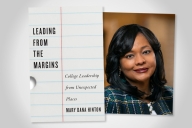You have /5 articles left.
Sign up for a free account or log in.
Graduate school is a great mystery to students, and to some faculty members, says Jessica McCrory Calarco, the author of A Field Guide to Grad School: Uncovering the Hidden Curriculum (Princeton University Press). Calarco is an associate professor of sociology at Indiana University. She believes many faculty members (as well as graduate students, of course) will benefit from her book. She responded to questions via email.
Q: How did you get the idea to write this book? Why did the issue speak to you?
A: This book started as a tweet. Or, rather, as a series of tweets about the hidden curriculum of higher ed. Ph.D. student Kristen K. Smith had tweeted about the need to better educate undergrads about grad school opportunities, and it made me think about how opportunities in academe are often hidden from grad students, as well. Reflecting on my own experiences in grad school, I thought about the many times I'd found myself embarrassed because of what I didn't know -- the difference between a working paper and one that's "forthcoming," what it means to write a literature review (it's not a review of all the literature on a given topic) or how big a conference poster should be. I shared those stories in the Twitter thread, and I encouraged other scholars to do the same. Those stories became the framework for the book, helping me identify the key parts of the hidden curriculum -- the knowledge and skills that aren't explicitly taught in grad school but still matter for success -- that I wanted to uncover for readers or help them uncover for themselves.
In that sense, this book is for grad students or prospective grad students, but it's also for faculty, too. One of the reasons the hidden curriculum of grad school stays hidden is because academia doesn't reward faculty for being the kinds of teachers and mentors who help their students develop key knowledge and skills. Meanwhile, the mentors who do make that time for students are disproportionately scholars from groups historically marginalized in academia (e.g., women scholars, scholars of color, LGTBQ scholars, scholars who were first-generation college students or who grew up in working-class homes). Because of the support they provide to students, those mentors are often overburdened with requests. And so this book is for those mentors, too -- a resource to share with their students and to share with colleagues as part of an effort to make the hidden curriculum part of the formal curriculum, instead.
Q: What are the mistakes that grad students tend to make when picking a program, and how should they avoid them?
A: I'd argue that students focus too much on the status of a program and not on the support they'll get while they're there. Certainly, attending a top-ranked program can increase a student's chances of getting a top-ranked job. But those job numbers ignore the fact that not every student in a top program gets a top job. And they ignore the fact that the students who get those top jobs are often the ones who came in needing the least support. That's in part because, as I mentioned before, academe doesn't reward good teaching or good mentoring, so there's incentive for faculty to work with and invest in students who can do more on their own. As a result, top-ranked programs can often feel disorienting and isolating for students -- like students from historically marginalized groups -- who often need more help in uncovering a hidden curriculum that wasn't designed for them.
What I'd recommend, then, is to ask a lot of questions and not just trust the rankings or the stats. Because certainly, there are some top-ranked programs and faculty at top-ranked programs committed to giving students the support they really need. And top-ranked programs sometimes have more resources to go around. But that isn't always the case. And the only way to find out is to ask. That's why A Field Guide to Grad School includes questions -- pages and pages of questions -- for students to ask when they're considering potential programs. And strategies to use in triangulating the answers to separate the marketing from the truth.
Q: What kind of professor makes a good adviser to a grad student?
A: I don't think there's a single kind of professor that makes a good adviser for grad students. And I think expecting one professor to provide all the support a student needs in grad school is far too much to ask. That's why I encourage students to build a team of mentors rather than try to find a single professor who can meet all their mentoring needs. In the book, I suggest that a good mentoring team has a topic person, a methods person, an advice/planning person, a person who writes effectively, a person who gives constructive feedback, a well-networked person and a person who has time listen and listens supportively, especially when things don't go as planned.
Certainly, some professors might check more than one of those boxes. But it's rare to find one professor to check them all. And if a student is lucky enough to find one of those magical unicorn professors, there's a good chance that professor is already overburdened with student requests. Building a team of mentors -- one that includes professors, other grad students, staff members and people outside academia like a therapist, partner or close friend -- can help students avoid overloading their advisers, broaden their network of contacts and ensure they get the support they need both in grad school and throughout their careers.
Q: What should a grad student know about the job market, especially now with COVID-19?
A: When it comes to the academic job market, one key thing to know is why there are so few full-time, long-term (i.e., tenure-track) jobs. These are the jobs for which most doctoral (Ph.D.) programs train students. But these jobs -- especially now with COVID-19 -- are becoming increasingly rare. And that's because most U.S. colleges and universities are struggling to make ends meet. Over the past 30 years, state and federal governments have de-invested in higher ed, shifting the costs of running public colleges and universities away from taxpayers and onto students and their families, instead. Colleges and universities have raised tuition to make up the difference, but those dollars still aren't enough. As a result, many colleges can only afford a few tenure-track professors, and they rely on large classes and underpaid adjuncts (instructors working on short-term, part-time contracts, often with no benefits), instead.
That undersupply of tenure-track positions has big consequences for students getting Ph.D.s. It means more competition for the few tenure-track jobs that are available, which means more pressure to publish and secure grant funding, even before finishing a degree. It also means that Ph.D. graduates have to be more willing to widen their search radius, looking outside their comfort zone geographically and/or considering non-tenure-track and nonacademic jobs. Non-tenure-track jobs often come with low salaries and little or no benefits, making nonacademic jobs more appealing for Ph.D. grads than they might once have been. Thankfully, and especially with the rise of big data and research-driven analytics, many nonacademic employers now recognize the value of hiring someone with a Ph.D. At the same time, and especially with the current pandemic-induced economic crisis, those jobs may also be few and far between.
In light of the tight job market, some universities are offering grad students extensions on normal requirements, essentially letting them stay in the program a little longer before getting their degree. That extra time can be helpful -- a chance to submit an extra paper or two for publication or apply for another award. But because of the same budget constraints that created a lack of tenure-track jobs in the first place, most universities and departments won't have funding to support students during that extra year or years. And that means that students finishing grad school in the wake of this pandemic may end up not only with fewer jobs prospects but also with a lot more debt.
Q: You talk about the "hidden curriculum." Should it be open?
A: As I explain in A Field Guide to Grad School, the hidden curriculum is most hidden from students in marginalized groups. Those access-based inequities then amplify inequalities among grad students and in academia as a whole. Uncovering key parts of the hidden curriculum -- like I do in the book -- is a way to make access more equitable. But one book -- even a very long book -- can't cover the whole hidden curriculum, especially the parts unique to specific disciplines, programs or degrees. That's why, as I argue in my conclusion, faculty and administrators should work to make the hidden curriculum part of the formal curriculum, instead. That means ensuring that all students are taught (and get support in learning) the skills and knowledge necessary for success in grad school and in the kinds of jobs they might get with their degrees. That work, in turn, will have to come from faculty and administrators. Because grad students can and should push for change. But -- as we've seen with the recent firing of grad students at the University of California, Santa Cruz -- their precarious position in academia leaves grad students vulnerable to pushback, even if they're pushing for support they desperately need.








